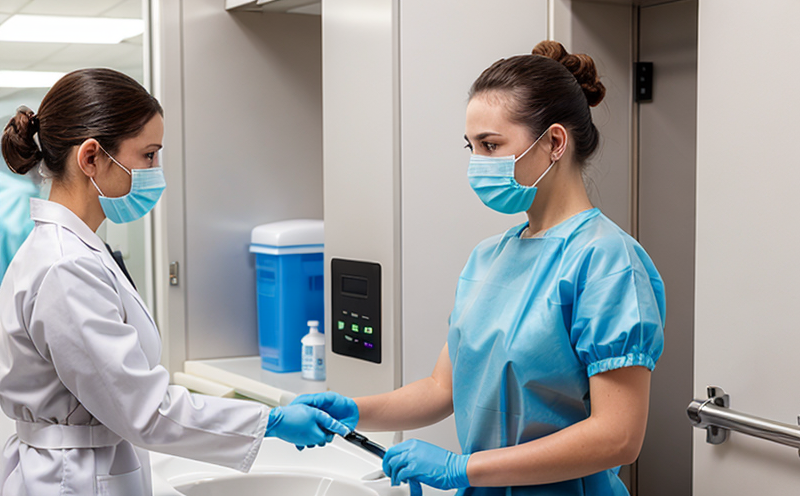ISO 20743 Textiles Determination of antibacterial activity of textile products
The ISO 20743 standard outlines a procedure to determine the antibacterial efficacy of textiles, which is essential for ensuring that consumer goods meet stringent hygiene standards. This service assesses how well textiles can inhibit bacterial growth on their surface or in contact with them. The test involves exposing textile samples to a standardized bacterial suspension and measuring the reduction in viable bacteria post-exposure.
Quality managers, compliance officers, R&D engineers, and procurement teams rely on this service to verify that products meet regulatory requirements for hygiene and safety. Textiles used in medical equipment, home textiles, and personal protective gear often undergo antimicrobial testing to ensure they are effective against common pathogens. Proper bacterial reduction is critical in preventing the spread of infection.
The test protocol meticulously defines the conditions under which textile samples should be exposed to bacteria. This includes specifying the bacterial species, inoculum concentration, incubation time, and temperature. The standard also provides clear criteria for interpreting results, ensuring consistency across laboratories worldwide.
Testing procedures typically involve soaking the textiles in a bacterial suspension for an extended period. Following exposure, the samples are rinsed to remove any remaining bacteria, dried, and then re-inoculated with fresh bacteria. This process is repeated multiple times to ensure reliable data. The efficacy of the textile is quantified by measuring the reduction in viable bacterial colonies compared to controls.
For accurate results, proper specimen preparation is crucial. Textile samples should be cut into standard sizes and shapes for uniformity. It's also important to account for factors like porosity and thickness, as these can affect how well bacteria adhere or penetrate the fabric. Compliance officers must ensure that all test specimens are prepared according to ISO 20743 guidelines.
The instrumentation used in this testing is sophisticated, including incubators capable of maintaining precise temperature settings and growth chambers for bacterial cultures. Sophisticated microbial counting techniques, such as agar plate methods or automated colony counters, are employed to quantify bacterial populations accurately.
Reporting results involves summarizing the percentage reduction in viable bacteria after exposure compared to untreated controls. This data is used by quality managers to make informed decisions about product safety and efficacy. Compliance officers can use these findings to ensure that products meet regulatory standards. R&D engineers gain insights into material properties that enhance antimicrobial performance, aiding in innovation.
Understanding the standard's scope helps stakeholders appreciate its importance in various sectors. The textile industry has seen growing demand for hygienic products as awareness of cross-contamination risks increases. Medical textiles, for instance, must meet stringent hygiene standards to protect patients and healthcare workers from infections.
Incorporating ISO 20743 into product development ensures that manufacturers comply with international regulations. This standard is widely recognized in the textile sector, providing a benchmark for quality assurance. By adhering to this protocol, companies can demonstrate their commitment to producing safe and effective products.
Scope and Methodology
The ISO 20743 standard specifies procedures for determining the antibacterial activity of textiles through standardized bacterial challenge tests. This section details the scope and methodology involved in this crucial service.
The standard applies to all textile products intended for use where antimicrobial properties are required, such as medical garments, bed linens, and workwear. The key focus is on assessing how effectively textiles can inhibit bacterial growth when exposed to specific bacteria under controlled conditions.
The methodology involves several critical steps:
- Preparation of the textile samples according to ISO 20743 guidelines
- Exposure of the samples to a standardized bacterial suspension for a specified duration
- Rinsing and drying the textiles post-exposure
- Re-inoculation with fresh bacteria and subsequent incubation
- Counting of viable bacterial colonies on agar plates or using automated colony counters
The test is designed to simulate real-world conditions where textiles come into contact with human skin. By following these stringent procedures, laboratories can ensure that the results are reliable and reproducible.
| Step | Description |
|---|---|
| Sample Preparation | Cutting textiles into standard sizes and shapes to ensure uniformity |
| Bacterial Exposure | Soaking samples in a bacterial suspension for the specified duration |
| Rinsing and Drying | Removing excess bacteria by rinsing and drying thoroughly |
| Re-inoculation | Reinfecting with fresh bacteria to ensure accurate quantification of reduction |
| Bacterial Counting | Determining the number of viable colonies using agar plate or automated methods |
The results are reported as a percentage reduction in viable bacterial colonies compared to untreated controls. This quantitative measure provides clear evidence of the textile's antimicrobial efficacy.
Eurolab Advantages
At Eurolab, we pride ourselves on providing comprehensive testing services that meet the highest standards of accuracy and reliability. Our expertise in ISO 20743 ensures that clients receive precise results aligned with international best practices.
We offer several advantages over other service providers:
- Accurate Results: Utilizing state-of-the-art equipment, we ensure accurate bacterial counts and reliable data.
- Comprehensive Reporting: Our reports are detailed, providing a comprehensive overview of test results along with recommendations for improvement if necessary.
- Expertise and Experience: Our team comprises seasoned professionals familiar with the nuances of ISO 20743 compliance.
- Rapid Turnaround Time: We understand the importance of timely results, ensuring that samples are processed efficiently without compromising quality.
- Compliance Assurance: By adhering strictly to ISO standards, we help clients meet regulatory requirements and ensure product safety.
- Customized Solutions: Our services can be tailored to meet the specific needs of our clients, whether it's for research or compliance purposes.
Our commitment to excellence has earned us a reputation as a trusted partner in the textile industry. Whether you're developing new products or ensuring existing ones meet standards, Eurolab is here to support your testing and certification needs.





